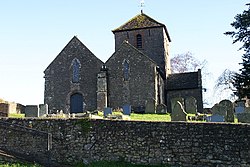Penhow
| Penhow Welsh: Pen-hŵ | |
| Monmouthshire | |
|---|---|
 The parish church of St. John the Baptist | |
| Location | |
| Location: | 51°36’54"N, 2°50’6"W |
| Data | |
| Post town: | Newport |
| Postcode: | NP18 |
| Dialling code: | 01633 |
| Local Government | |
| Council: | Newport |
| Parliamentary constituency: |
Newport East |
Penhow is a small village and parish to the east of the city of Newport in Monmouthshire. The name Penhow is believed to be derived from the Welsh language word Pen meaning head or top and How derived from the Old Norse word Haugr meaning hill or mound.[1]
History and architecture
Roman remains
Fragments of Roman building material have been found in the area.[2]
Penhow Castle
Penhow is best known for Penhow Castle. It was built as a home for Sir Roger de St Maur, one of the Norman knights who served the Norman Lord of Striguil at Chepstow Castle. He built a tower house, and documentary evidence shows that he was at Penhow by 1129. It was the first British home of the family who would later rise to national prominence under the more familiar name of Seymour. Later the Seymour family sold Penhow Castle to the Lewis family of St. Pierre, who converted the castle to a modern residence in 1674. Thomas Lewis' son Thomas was High Sheriff of the county, and married the daughter of Sir Richard Levett, Lord Mayor of London. The Lewis family retained ownership of Penhow Castle for several centuries.[3]
The castle, which has a reputation for being haunted,[4] was open to the public between 1978 and 2002.[5]
Church of St. John the Baptist
The parish church of St. John the Baptist is next to the castle. It has 13th-century origins and was the subject of restoration work in the 19th century.[2]
Rock and Fountain Inn
The Rock and Fountain Inn is a 17th-century coaching inn on the edge of the village. The historic inn and its five acre site underwent a £1m renovation and redevelopment during 2010. The inn reopened as a steak and seafood restaurant in November 2010.
Amenities
Local pubs also include the Groes Wen. The property was formerly a cottage but was converted in 1881 by then owners, a Mr and Mrs Lewis, who left their jobs as a hoop shaver and a grocer to become publicans.[6]
References
- ↑ The Village of Penhow Heritage
- ↑ 2.0 2.1 John Newman, The Buildings of Wales: Gwent/Monmouthshire, 2000, ISBN 0-14-071053-1
- ↑ Penhow Castle, castlewales.com
- ↑ Psychic investigation at Penhow Castle
- ↑ Penhow Castle closes to the public
- ↑ "The Groes Wen Inn" at vintageinn.co.uk